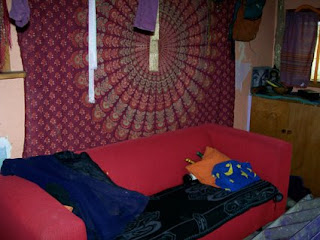As I mentioned in an earlier post, I would like to cover a gambit of nomadic homes with a house-truck, canal-boat and go anywhere cruising yacht.
Because the yacht is the biggest project of all, it is the first project for me to start. The others will take place during the project to build the yacht.
The yacht I have chosen to build, is by an American designer, by the name of Tom MacNaughton. The design is called Crown Jewel. It is a heavy displacement flush deck yacht of 35'6" length and a laden displacement of around 9 ton. It is rigged with a single Junk sail, on a free standing mast. To see one of these boats sailing, click on the S/Y Linnea link in the blog roll of this blog. This example was built in Sweden by Matti Palm and family. Matti started building Linnea about nine or ten years ago and while he still needs to finish building the interior, his family have been sailing in her, for the last two years.
The next largest project will be a canal boat. The biggest issue for me with choosing a canal boat is that I live in New Zealand, which isn't exactly renown for it's canals. In fact the canals I would like to spend time on, are all on the other side of the world. So for me, the most practical option, is to find a design that will fit inside a shipping container. While most canal boats are built out of steel (for practical reasons), it is not a material that I intend on using. My preference in this case would be plywood, covered in glass cloth and epoxy, which can be given protection with a couple of beltings of stainless steel tubing. One near the waterline and another, higher up. At the moment I am looking at a design called Topaz, by American designer Philip C. Bolger.

It is 31' long, by 7'4" wide, with a fully loaded hull draft of 11". Ideally I would like to add an additional three to six feet in length, so as to be able to add heating, additional storage and a showering/washing area. I have sent a letter to the designer to ask about the feasibility of doing this. It is not wise to change the dimensions of a boat, without having it checked out by a competent naval architect, as it can have big negative effects on the capability of the vessel and equally it can increase the cost and complexity of construction out of all proportion, even when only making what appear to be small changes to the hull. It will be interesting to see what kind of response I get.
For my land based nomadic home, I intend on getting an old chiller truck, with a net weight of around four or five ton and a gross laden capacity of about seven to nine ton. Something similar to Kevin's truck, from an earlier post here. The reason I am looking at using an old chiller truck is that they seem to be about the same price as other comparable trucks, but they already have a fully insulated building on them. So all that would need to be done, is to fit it out. In fact I could use it from day one, just by throwing in camping gear that I already have, then fit it out as time and resources allow. In fact with some wood, epoxy and paint, I already have most of the stuff to fully set up a nice house truck now, except for the truck itself, which I intend to buy in about two to three years from now.












